
About UsThe Numismatic Bibliomania Society is a non-profit organization promoting numismatic literature. For more information please see our web site at coinbooks.org SubscriptionsThose wishing to become new E-Sylum subscribers (or wishing to Unsubscribe) can go to the following web page link MembershipThere is a membership application available on the web site Membership Application To join, print the application and return it with your check to the address printed on the application. Membership is only $15 to addresses in the U.S., $20 for First Class mail, and $25 elsewhere. For those without web access, write to: David M. Sundman, Secretary/TreasurerNumismatic Bibliomania
Society AsylumFor Asylum mailing address changes and other membership questions, contact David at this email address: dsundman@LittletonCoin.com SubmissionsTo submit items for publication in The E-Sylum, just Reply to this message, or write to the Editor at this address: whomren@coinlibrary.com
BUY THE BOOK BEFORE THE COINYou won't regret it! |
- WAYNE'S WORDS: THE E-SYLUM NOVEMBER 22, 2009
- DAVID F. FANNING NUMISMATIC LITERATURE UPDATE
- GENGERKE'S AMERICAN NUMISMATIC AUCTIONS BOOK AVAILABLE ONLINE
- ONLINE BOOK: HISTORY OF THE OLD FORT COIN CLUB
- BOOK REVIEW: JOHN SPRING, ANCIENT COIN AUCTION CATALOGS: 1880-1980
- NEW ONLINE BOOK: HISTORY AND COINAGE OF DACIA
- ONLINE BEBEE PAPER MONEY COLLECTION EXHIBIT UPDATE
- MORE ON NEWTON AND THE COUNTERFEITER
- MORE ON THE E-SYLUM AND THE AMAZON KINDLE READER
- JULIAN LEIDMAN RECOVERS STOLEN COIN INVENTORY
- 1772 RESOLUTION AND ADVENTURE MEDAL CLICHÉS
- STACK'S DECEMBER 2009 COIN GALLERIES SALE
- WALTER BREEN AT JOHNS HOPKINS
- HOWARD DANIEL'S LETTER FROM HO CHI MINH CITY
- THE HENRY FAUNTLEROY HANGING PENNY
- AUSTRALIAN SLOUCH HAT PENNY CARVERS
- 1911 GOLD TIFFANY LIFE SAVING MEDAL OFFERED
- VICTORIA CROSS SELLS FOR RECORD 1.5 MILLION GBP
- WALL STREET JOURNAL ON RISING NUMISMATIC PRICES
- NEW YORK TIMES ON THE ADVANCE OF ELECTRONIC CASH
- GOT CASH? YOU'RE A CRIMINAL SUSPECT
- M.V. LAKSHMINARAYANA'S NUMISMATIC MUSEUM
- CHINESE ARTIST DUPLICATES BANKNOTE WITH EGG-SHAPED ROCKS
- SRI LANKA ISSUES BANKNOTE TO MARK END OF TAMIL WAR
- KENYA MAY BAN PORTRAITS ON ITS BANKNOTES
- BANKNOTE 2009 CONFERENCE IN WASHINGTON DECEMBER 6-9
- SOMALI PIRATES CHECK RANSOM CASH FOR COUNTERFEITS
- SPANISH SCIENTISTS TRAIN MOUSE TO DETECT COUNTERFEIT COINS
- WOMAN LEAVES $40,000 AT SHRINE FOR SAFEKEEPING
- FEATURED WEB PAGE: MONEY HATS
WAYNE'S WORDS: THE E-SYLUM NOVEMBER 22, 2009

No new subscribers this week - our current subscriber count is 1,269. Hmmm. Maybe we HAVE hit a subscribership plateau. But don't tell me there are no more than 1,269 serious numismatists in the world. Give a free gift subscription to a friend (send me their email address and we'll sign them up)!
One item that fell through the cracks last week was this note from Richard Doty of the National Numismatic Collection:
On numismatic encyclopedias, I wrote one for Macmillan, published here and in the UK in '82. It's worth a look, has many basic terms, coins, etc., etc. About five hundred entries, as I remember.
This week we open with an update from dealer David Fanning. Next up, Martin Gengerke's book update is available on the web, as are e-books from the Old Fort Coin Club and Dane Kurth.
Other topics include Walter Breen's time at Johns Hopkins, the Henry Fauntleroy hanging penny, a 1911 Tiffany Lifesaving medal, and a record $2.5 million price for a medal.
To learn about the Australian slouch hat penny carvers, Somali pirates, Spanish scientists and how to release the artistic design talents of a central banker, read on.
Wayne Homren
Numismatic Bibliomania Society
DAVID F. FANNING NUMISMATIC LITERATURE UPDATE
Illustrated is an 1714 edition of Massachusetts Acts and Laws including laws pertaining to circulating coinage. Also offered is a contemporary newspaper printing of the 1786 Massachusetts Mint Ordinance and other rare items relating to numismatics in the colonies. -Editor
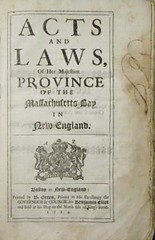 David F. Fanning Numismatic Literature were in attendance at this week's C4 Convention in Boston, Massachusetts (part of the Bay State Coin Show). Fanning brought with him a small but select group of 18th-century American and British publications of numismatic interest, and prepared a "mini-catalogue" describing them, which can be downloaded from the firm's Web site at
www.fanningbooks.com
.
Some items may still be available for purchase.
David F. Fanning Numismatic Literature were in attendance at this week's C4 Convention in Boston, Massachusetts (part of the Bay State Coin Show). Fanning brought with him a small but select group of 18th-century American and British publications of numismatic interest, and prepared a "mini-catalogue" describing them, which can be downloaded from the firm's Web site at
www.fanningbooks.com
.
Some items may still be available for purchase.
The catalogue of the firm's third mail-bid auction (closing December 3) is also available on the site for those who have not received a hard-copy version. Bidders are encouraged to send their bids in promptly.
GENGERKE'S AMERICAN NUMISMATIC AUCTIONS BOOK AVAILABLE ONLINE
As mentioned last week, an updated version Martin Gengerke's American Numismatic Auctions book is now available online at the Numismatic Bibliomania Society web site, on the Community Resources page.
He's received several updates from contributors just this week, and with this publication he'll undoubtedly receive some more. This is an important list for numismatic researchers, so please take a look and fill in gaps where you can, particularly in the area of auction catalogs published in the last decade or so.
In addition to Martin, we owe thanks to our NBS webmaster Bruce Perdue and NBS Secretary-Treasurer and his team at Littleton Coin Company for composing a free full-page ad for NBS in the book.
Reading the book's acknowledgement section was a trip down memory lane. I feel like an old-timer now, but once upon a time I was the new kid in the hobby of collecting American numismatic literature. Many of the good friends and mentors I met along my journey, many of them key figures in the early days of NBS, are now deceased. I visited many of them at conventions, and visited their homes and libraries. Rest in peace, my bibliophile friends:
- Douglas Ball
- John Bergman
- Walter Breen
- Armand Champa
- Jack Collins
- John Ford
- Frank Katen
- Ken Lowe
- Lester Merkin
To access the NBS Community Resources page, see: http://www.coinbooks.org/resources/
ONLINE BOOK: HISTORY OF THE OLD FORT COIN CLUB
George Fitzgerald writes:
I am the President of the Old Fort Coin Club in Fort Wayne, IN. We had our 50th year in 2006. We have been working on a book of our 50 years, and it is now on line on our web site, oldfortcoinclub.org. Anyone can down load it. It is 144 pages.

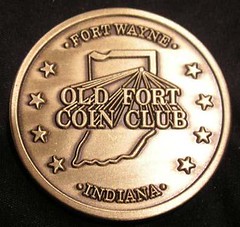
October 10, 1957
A very interesting talk on Lincoln medals and allied interests. Also
with questions and answers with explanation was given of the
various aspects of medals. The lecture was given by Dr. McMurtry
who was the director of the Lincoln Museum at the Lincoln Life
Insurance Company.
December 12, 1957
A Coin Quiz was given with very hard questions from the Red
Book. Ken Hallenbeck won the prize. It was an 1818 Spanish
milled dollar – A.D. Noble.
September 13, 1962
Ken Hallenbeck gave a detailed report on the American
Numismatic Association convention.
September 10, 1964
George C., Courtesis gave a report on the club library. A moth
flew out of an old book when it was held up. It was the 1887
Illustrated History of the United States Mint.
December 12, 1968
John Shaffer read an account written by a Michigan man about the
final hectic hours of the redemption of Silver Certificates at the
San Francisco Mint.
October 10, 1996
Beth Deisher of Coin World talked about her past.
November 11, 1999
Kenneth Chen of Coin World spoke on "How to Use the Internet
and How the Internet is Affecting the Coin Collecting Hobby."
To read the complete book, see: 50th Anniversary Book (www.oldfortcoinclub.org/OFCC50thAnniversaryBook.aspx)
BOOK REVIEW: JOHN SPRING, ANCIENT COIN AUCTION CATALOGS: 1880-1980
 John Spring, Ancient Coin Auction Catalogs: 1880-1980 (2009), self-published, distributed by Spink (but not yet on their website). 369 large pages describing 886 auction catalogs. Charles Davis is selling this for $110 and CNG is selling slightly bumped copies for $95.
John Spring, Ancient Coin Auction Catalogs: 1880-1980 (2009), self-published, distributed by Spink (but not yet on their website). 369 large pages describing 886 auction catalogs. Charles Davis is selling this for $110 and CNG is selling slightly bumped copies for $95.
It's a nice book! Every catalog is described by size and color. The number of plates — Celtic, Greek, Roman aes grave, Roman Republican, Roman Imperial, Roman Provincial, Byzantine, and "barbarian migration" — is given. There is often information about the collector, collection, or auctioneer. Sometimes that information comes from the catalog, but Spring also seeks biographical information from other published sources such as obituaries in numismatic journals. The photos depict the collector or firm. The catalogs themselves are not pictured.
The author does not judge the paper quality, the method of reproduction of the plates, nor the numismatic merit of the coins.
To read the complete article, see: John Spring, Ancient Coin Auction Catalogs: 1880-1980 (digitalhn.blogspot.com/2009/11/john-spring-ancient-coin-auction.html)
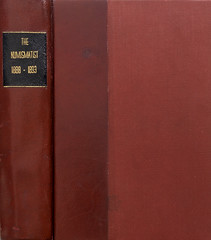

NEW ONLINE BOOK: HISTORY AND COINAGE OF DACIA
Dane Kurth writes:
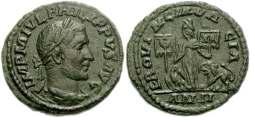 I have just uploaded another book to archive.org. When I took over the Wildwinds web site after Dave Surber's death, I downloaded well over 1.5 million files from the old server in order to save as much as I could before it was all destroyed by that hacker and/or the server switched off.
I have just uploaded another book to archive.org. When I took over the Wildwinds web site after Dave Surber's death, I downloaded well over 1.5 million files from the old server in order to save as much as I could before it was all destroyed by that hacker and/or the server switched off.
I still haven't looked at them all but last night I found a book which Dave had prepared, called "The History and Coinage of Dacia".
It is mainly based on the Moushmov list, but I added the images (there were only links to them, as it was in html format), added some more images from friends and shops from whom I have permission to use their images, and transferred it to pdf format.
It is now online at archive.org but I put a "non-commercial use" copyright on it, according to Dave's philosophy which was "if you can put it at people's disposal for free, then do so".
I had to use my name as co-author to comply with copyright rules. Anyway, in case anyone wants it, it is only 12 pages but quite interesting and can be downloaded as a free pdf file.
From the book's foreword and dedication:
Dave Surber was the founder of the popular coin identification website, wildwinds.com. For 12 years he ran the website in his spare time, scouring the internet for new coins to add and paying for 99% of the upkeep and very high server costs from his own pocket. In time, several people, including myself, began to submit batches of coins for addition to the html database, soon making it the largest online collection of ancient coin images and information on the internet.
Dave tragically died in February 2009. Soon afterwards the website was almost entirely destroyed by a malicious hacker. I became the proud new administrator of the website in early May 2009 and thanks to Marie Surber, who gave us access to every single wildwinds file on Dave's PC, by late May the website was completely restored and running on a new server. Since then many hundreds of new coins have been added to all the sections and coins are being submitted all the time.
Whilst sorting out some of the old files I came across this file and its images in html format. It appears to have been written in 2007 but was never published in any form. I have transferred the information to a pdf and hereby make it openly and freely available to the numismatic community. This work is dedicated to my dear friend, Dave's widow, Marie.
To read the complete article, see: History and Coinage of Dacia (www.archive.org/details/HistoryAndCoinageOfDacia)
ONLINE BEBEE PAPER MONEY COLLECTION EXHIBIT UPDATE
For the ANA meanwhile, John created very high-resolution photographs of the ANA's Bebee collection of U.S. paper money. We recently announced the availability of new web pages featuring the notes.
But John didn't stop there. His original images were too large and detailed to use as-is on the site, but taking a page from the Google Maps playbook, he set about creating programs to slice the images into bite-sized chunks for faster loading. Now visitors to the Bebee web pages and click on the notes to view the high resolution images. Here's his story of how he did it.
The high-definition images are something to behold - see details you've never viewed so clearly before. Check it out! -Editor

All the Bebee banknotes are now clickable and the instructions linked from http://ana-museum.org have been changed to reflect that.
To keep the download time reasonable, each of the higher-resolution (40"+ wide on a 100 dpi monitor) images was sliced into 2000+ 64x64 pixel squares, only 64 of which are loaded on a mouse click. Since the images are cached by the browser, repeated clicks in the same area load fewer squares.
The slicing process went well beyond the capabilities of Photoshop, so I used a program originally written for the Unix environment, ImageMagick (www.imagemagick.org), to do the slicing. This worked on all but the imges of uncut sheets which had to be pre-sliced in half.
Currently the site has 2+ million slices. A separate virtual disk was set up for the site so it would have its own file system due to the large number of potentially active files. Using the file system rather than a database for a static application such as a web site allows the operating system to manage its caching over all applications instead of optimizing one at the expense of others.
A Javascript loaded with each HTML page runs within the browser to pull in the slices. A number of Perl programs organized the one-time work on the server for ImageMagick's slicing which took about 3 days of CPU time on a fast mainframe, and other programs modified the hundreds of existing HTML files so that they would call the Javascript routines.
This turned out to be quite interesting and fun although I had my doubts at first, especially when Photoshop went into an infinite loop whenever I tried anything less than a 256x256 slice.
To view the Bebee Collection online gallery, go to www.money.org (select "Visit the Money Museum," then select "The ANA Bebee Collection of U.S. Paper Money/View the Collection")
To read the earlier E-Sylum article, see: ANA DEBUTS ONLINE BEBEE PAPER MONEY COLLECTION EXHIBIT (www.coinbooks.org/esylum_v12n44a06.html)
MORE ON NEWTON AND THE COUNTERFEITER
Michael E. Marotta writes:
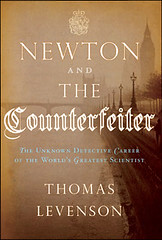 When I proposed a review of Newton and the Counterfeiter, Wayne Homren asked how this book compares to Craig, meaning Newton at the Mint by Sir John Craig (Cambridge, 1946). At that moment, all I had to rely on was my own feature article from the November 2001 Numismatist. Since then, I did some work.
When I proposed a review of Newton and the Counterfeiter, Wayne Homren asked how this book compares to Craig, meaning Newton at the Mint by Sir John Craig (Cambridge, 1946). At that moment, all I had to rely on was my own feature article from the November 2001 Numismatist. Since then, I did some work.
Craig also wrote two other monographs. "Isaac Newton-Crime Investigator," Nature, 182 (19 July 1958) 149-152 tells the tale. Levenson adds nothing and takes much. "Sir Isaac Newton and the Currency," by G. Findlay Shirras and J. H. Craig, The Economic Journal Vol 55. No. 218/219 (June-Sept 145) 217-241 provides some information about the general problems of counterfeit coins in circulation, but does not go into the story of Newton versus Chaloner.
There is another dimension, not discussed lately, though addressed by Sir John Craig: Chaloner did not get a fair trial. Craig maintains that Chaloner was factually guilty, but deprived of due process. In fact, all we have to go on is the trial record, the prosecutor's (Newton's) records, and an anonymous biography of Chaloner written after his conviction and execution. Under English law (including the American system), the jury is the trier of fact. If the trial was unjust, then it is an epistemological contradiction -- begging the question and asserting the hypothesis -- to claim that the accused was "really" guilty.
The bottom line is that Thomas Levenson is a videographer of science. For the numismatist, he presents no new facts. The story he tells is lively. He puts you on the streets. If you do not know the story or want something more lively than Sir John Craig's account, then this book is worthwhile.
To read the Michael's earlier review, see: BOOK REVIEW: NEWTON AND THE COUNTERFEITER (www.coinbooks.org/esylum_v12n32a03.html)
MORE ON THE E-SYLUM AND THE AMAZON KINDLE READER
Regarding last week's item about the availability of The E-Sylum on the Amazon Kindle book reader, Rich Bottles writes:
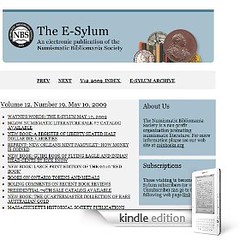 By the way, many new authors are surprised when they see that their new Kindle publication is initially only available "outside of the U.S." This seems to be a technical glitch on Amazon's part. It should in fact be available everywhere and I believe Amazon will eventually fix this confusing reference.
By the way, many new authors are surprised when they see that their new Kindle publication is initially only available "outside of the U.S." This seems to be a technical glitch on Amazon's part. It should in fact be available everywhere and I believe Amazon will eventually fix this confusing reference.
Another frustrating practice of Amazon's is that it will include a question box on the print-edition page for a title asking customers if they want to see this title available on Kindle. The problem is that the title sometimes is already available on Kindle, but because Amazon includes this question on the page for the print edition, customers assume that it is not yet available and do not bother looking for a Kindle edition.
Fred Schwan writes:
I was interested to read about The E-Sylum appearing on the Kindle and especially by your comments thereon. Your comments seem to be of casual interest rather than issues of copyright. I can understand our collective desire to see widespread distribution of our beloved E-Sylum, and yes, subscriptions are free, but I am not at all sure of the legality (or appropriateness) of reselling copyrighted material without permission (or compensation).
It is even likely that you would gladly give permission, but have you? Actually, can you? I assume that items submitted (like this letter) are the property of the submitter. At a minimum, in the finest tradition of The E-Sylum, this is possibly a topic for lively discussion in the pages, er, electrons of the E-Sylum.
As for The E-Sylum's republication of its reader's submissions, that's what we've been doing weekly for over twelve years without a peep from our contributors. As you note, subscriptions are free to all and back issues are archived almost immediately on the NBS web site, freely available for all the world to see. By submitting a query or article to The E-Sylum, contributors are giving their implicit permission for republication. But that doesn't mean they're giving up the copyright to their own words - that stays both with the original author and The E-Sylum.
Our republication of images and text excerpts from other publications is done under the Fair Use doctrine. As part of the Press, we are free to use these in the context of our own publication. That doesn't give us the right to completely republish articles verbatim, and in the case of print publications like Coin World and other numismatic e-zines (like Fred's MPC Gram) I usually ask for permission to excerpt even though I may not technically be required to. I was a little concerned about this when I started The E-Sylum, but in twelve plus years of publishing I've never had a quoted publication contact me with an objection.
For the last couple years The E-Sylum has carried advertisements, and for several years before that the NBS web archive has carried Google ads. These are a small way for the editor and NBS to get some compensation for our efforts, although it only amounts to maybe, what - a nickel an hour? But it adds up to lunch money by the time a check arrives, and yours truly has a couple extra pounds around the waist to prove it.
Amazon charges its Kindle subscribers $1.99/month for an The E-Sylum subscription, but that fee helps cover the cost of Amazon's wireless distribution system, and some of that money would make its way back to the publisher, although I have yet to see a dime. We may actually have a Kindle subscriber or two, but I haven't logged in to check yet. -Editor
To read the earlier E-Sylum article, see: THE E-SYLUM AVAILABLE ON THE AMAZON KINDLE READER (www.coinbooks.org/esylum_v12n46a03.html)
JULIAN LEIDMAN RECOVERS STOLEN COIN INVENTORY
Julian penned the following email to friends this week, and he gave me the OK to publish it here in The E-Sylum. Versions of this have also been published elsewhere online.
The engraved 1921 dollar or the booklet that accompanied it have not turned up yet, but Julian tells me he'll know better this week which items have been recovered. -Editor
As most of you know, my car was broken into during my return from a show last month. I received many phone calls about the missing coins, but nothing matched.
On Oct. 29, I received a call from an eastern dealer who does not want to be named at this time. He was being offered some coins and asked me about them. After he had mentioned three coins, I was virtually certain that these were, indeed, the stolen inventory.
I then called the police detective that had been working on the case and gave him the information. By late that afternoon, he had set up, in conjunction with the FBI and another agency, a meeting for the next morning to view the coins.
Early Oct. 30, my son, Sam, and I drove to meet with the assembled law enforcement officers. The original plan was abandoned and the eight officers then went to the place that the coins were supposed to be, while Sam and I waited to be called to identify the items.
After nearly an hour, I was called and eventually told that it really wasn't necessary for me to identify the coins, as my name was all over them. A few minutes later, I went and saw the coins, which were all mixed up, but very few had been removed from the 2 X 2's and I don't think that any had been broken out of their encapsulation, either.
The following Tuesday, I went to examine the coins more closely and found over 1700 coins and 300 notes in the custody of the FBI. The vast majority of the volume was there. There were some notable items missing.
The following week, the FBI made another visit, but no items were found. On Nov. 12, the FBI called and said that they were going to get some more coins and on a subsequent call, I was told that more coins including at least one item that I had noted as still missing, previously.
I have not been to examine this second group of coins yet, but will do so in the very near future.
As of this date, the original thieves have not been apprehended and I am not certain of exactly what else might be missing. This is an ongoing investigation and I am being as forthcoming as I am able to be at this time.
I am unable to express, adequately enough, my appreciation to the hundreds of well wishers and especially to the many, many, people that pledged money to a reward fund that was started by Jon Lerner and Laura Sperber. Many of my colleagues in the PNG also added to this fund and I will be eternally in their gratitude, as well.
The numismatic press and the general press gave this a great deal of publicity and I believe that because of this publicity, the coins were able to be identified. I want to express my appreciation to, in no specific order, Coin World, Krause Publications, the Coin Dealer Newsletter, Heritage Numismatic, the various dealer networks, as well, and of course the message boards on CU and NGC. Doug Davis of the NCIC offered me his good offices, as well.
The law enforcement agencies, from the local police to the FBI, have been true professionals and are continuing to be as supportive as possible. I will probably never be able to properly express my appreciation to them either.
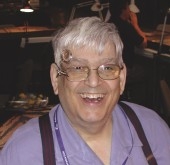
To read the earlier E-Sylum article, see: COIN DEALER JULIAN LEIDMAN VICTIM OF VEHICLE BURGLARY (www.coinbooks.org/esylum_v12n42a11.html)
THE BOOK BAZARRE
1772 RESOLUTION AND ADVENTURE MEDAL CLICHÉS
1772 Resolution and Adventure obverse and reverse cliches. Tin. Betts-552, var. Nearly As Made.
Both are nearly paper thin, thin enough that the designs are seen incuse on the backs of each. On a typical cliche (or epreuve, also known as a splasher or proof), the back of the cliche would be flat, pushed flush against a tabletop, often against a piece of scrap paper (presumably so the bubbling tin would not scald the furniture!). These cliches must have resulted from the dies being pushed into a more malleable surface, perhaps molding clay, to allow for the contours of the die to be seen even on the back.
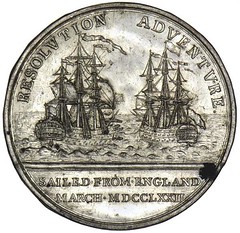
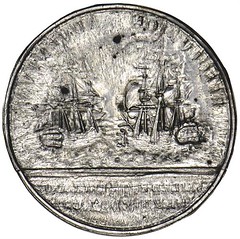
These are among the earliest witnesses to the production dies for the famed Resolution and Adventure medals carried by Captain Cook into the Pacific. The obverse is signed under the bust truncation WESTWOOD F.; it would be modified to B:F when the normal production run began. The reverse is in its finished state, but lacks the significant die crack in the exergue common to all normal strikings, suggesting the crack appeared in hardening. These would have been produced by the engraver personally, likely as samples to show Joseph Banks, the noted scientist who oversaw the medal's production.
To read the complete lot description, see: 1772 Resolution and Adventure obverse and reverse cliches. (www.stacks.com/lotdetail.aspx?lsid=AN00000739&asid=&lrid=AN00157922)
STACK'S DECEMBER 2009 COIN GALLERIES SALE
- The Collection of a Bust Half Dollar Enthusiast
- The Jerry Byrne, Sr. Collection
- The Estate of Vera Easling
- The Richard Gross Collection
- The Rev. Paul Harwell Collection
- A Distinguished Collection of Early American Lottery Tickets
- Mexican Silver Cobs from the Lucayan Beach Wreck
- The Maryland Historical Society
- A Comprehensive Collection of Medals of the Napoleonic Era
- A Northeastern Collection
- The Cecil Simpson Collection
- The Sleepy Hollow Collection
- The Stack Family Collection
Click on the link below the images to see the full lot description. These are not million-dollar items and some are quite inexpensive. I've always enjoyed pieces like the German notgeld and East India coins, and used to have some in my collection. I wasn't aware of the "pirated version" of the Erie Canal completion medal. Great toning! -Editor
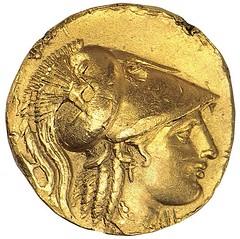
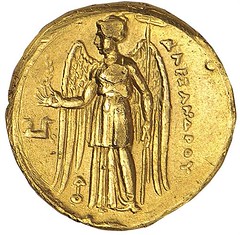
Lot 32: Alexander III, 336-323 B.C. Stater
KINGS OF MACEDON. Alexander III 'the Great', 336-323 B.C.
AV Stater. Lampsakos, ca. 328-323 B.C. Head of Athena right, wearing crested Corinthian helmet decorated with a coiled serpent. Rv. Nike standing left, holding wreath and stylis; in left field, conjoined foreparts of two horses; below left wing, monogram. 8.33 grams. Price 1358. Ex jewelry.
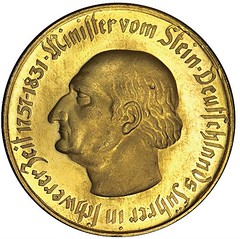
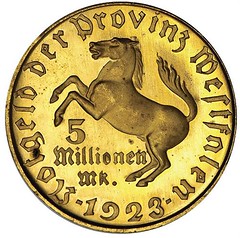
Lot 564: Westphalia Notgeld. Bronze goldplate 5 Million Mark, 1923
Bronze goldplate 5 Million Mark, 1923. Obv. Prime Minister Baron vom Stein head l., Germany's Leader in More Difficult Times. Rv. White Horse of Westphalia. Struck during French occupation after World War I. Reverse shows value in three lines. J.21. A key to this complex series.
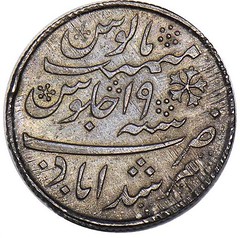
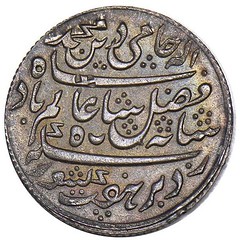
Lot 774: British East India Company ½ Rupee
INDIA. British East India Company. Bengal Presidency.
½ Rupee, Year 19 of Shah 'Alam II, frozen date. Murshidabad. Persian inscription on both sides, snowflake-like mintmark. KM 101. Modern machine struck coinage, straight reeding.
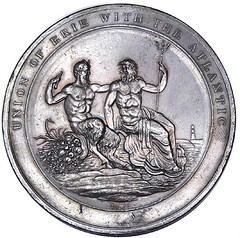
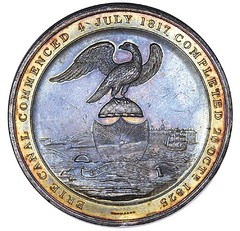
Lot 1409: 1825 Erie Canal Completion Medal
1825 Erie Canal Completion Medal. White metal. About Uncirculated.
81.5mm. By Sir Edward Thomason after Charles Cushing Wright. Forest god Pan seated with sea god Neptune. Rev. New York State Arms, legend gives dates of commencement, completion. Struck by Thomason as a pirated version of the smaller C.C. Wright original that was commissioned by the New York authorities. Reverse exhibits fascinating tawny red-gold peripheries and clear blue at center.
WALTER BREEN AT JOHNS HOPKINS
Walter Breen entered the Johns Hopkins University in the fall of 1951 and graduated only 10 months later with a degree in mathematics. I thought it would be interesting to find the 1952 Johns Hopkins yearbook — called the Hullaballoo — to see if Breen was in it. I have wondered if he really completed four years of coursework in just 10 months, but as it turns out he did indeed.
A photograph of a clean-shaven Breen appears on page 70 of the Hullaballoo, with the following text: WALTER H BREEN / 215 East University Parkway, Baltimore 18, Maryland; humanities ΦBK. (215 East University Parkway no longer exists – it was torn down to make room for the expansion of Union Memorial Hospital.) Another picture of Breen is on page 97, where there is a group photograph of the members of Phi Beta Kappa. Breen does not seem to have been involved in any campus activities.

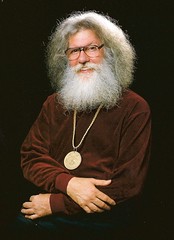
The 100th issue (July 1995) of The Colonial Newsletter provides some interesting snippets from the correspondence between Breen and Ray Williamson, an early mentor of Breen's. A few letters were written while Breen was at Johns Hopkins, such as one dated August 21, 1951, where Williamson wrote,
"Judging by the above address listing, from the ANA Director, [‘Box 575, The Johns Hopkins University, Baltimore 18, MD'] You have been accepted for work at Johns Hopkins. If so, congrats and power to you. I'd be interested to know what courses you're taking and how you get along. For God's sake don't let coin collecting (or correspondence) interfere with your getting a degree. Four years isn't so long."
As mentioned above, Breen was able to get his degree in less than a year. On April 1, 1952 Breen wrote a letter to Williamson from Johns Hopkins that reveals his "light" schedule:
"…Though I have nothing that could be called a ‘spring vacation' except the Easter holidays, which I am spending in Massachusetts…I do herewith gratefully accept your invitation for the weekend of the 18th-20th. This will cause no difficultly whatever with my studies, because my schedule is light and I will miss no more than one class if I leave before Friday 3PM…I might either hitchhike or come by bus, but in either case, I'll call you as directed. Therefore, you may expect me without fail that afternoon or evening."
In a letter dated May 24, 1952, Breen wrote to Williamson, "Did I tell you, by the way, that the Maryland Alpha Chapter (JHU) of Phi Beta Kappa has elected me to membership. A most unexpected honor…." Immediately after graduation Breen went to work for Wayte Raymond, and he would later earn his master's degree at the University of California, Berkeley. CNL 100 only printed excerpts from Breen's early correspondence with Williamson, and I am curious if any letters mention Breen working with the coin collection at Evergreen House during his time at Johns Hopkins.
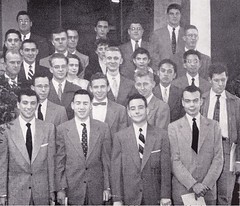
THE BOOK BAZARRE
HOWARD DANIEL'S LETTER FROM HO CHI MINH CITY
I am over here in my townhouse home office in Ho Chi Minh City (Saigon) and reading your Wayne's Numismatic Diary for November 10, 2009 where you describe Clyde's Restaurant being "perched atop one of the few hills in the area." As a numismatic researcher, it is also difficult for me to not research anywhere I am living to learn about its past and also the plans for the future. The "hill" you described is named Gantt Hill and is "the" highest peak in Fairfax County, and is sometimes called "The Mountain of Fairfax." It is 512 feet above sea level and the peak is on the grounds of The Rotonda Condominium, just behind my unit. For those who use or remember Gantt Charts, the hill's namesake is related to the man who invented the charts.
You also mentioned that the November Nummis Nova dinner was Traci Poole's last because she was moving back home to Idaho. I sent an email to her employer, Wizard Coin Supplies, to say goodbye and discovered she will be working the January 2010 FUN Show in Orlando, FL as her last work for them. I will have a club table there for NBS and some other numismatic organizations and can personally say goodbye to her with a hug. Unlike your wife, I have no restrictions from my wife because she says I am so old I cannot follow up on anything after the hug anyway!
For those readers who want books about Vietnamese numismatics, there is a new one over here besides mine. It is titled Tiến Giấy Việt Nam Qua Các Thò'i Kỳ (Tù' 1875 - 2006). The author's name is Nguyễn Hoàng Xuân Vinh. He self-publishes it and his printings are about 5 each, and each one is different as he finds new images and/or information on the internet. I have had a message sent to him that I will pay for his travel and put him up in a nearby hotel for a couple of days to assist him in creating a better reference. I hope he takes me up on it......we shall see.
I also have some good news from over here. My latest catalog; Socialist Republic of Viet Nam Coins & Currency, was bought by HASABA and FAHASA, the two national bookstore chains here in Viet Nam. Besides preserving the history of Vietnamese financial instruments with my catalogs, I also want to generate more collectors here in Viet Nam and hopefully, the bookstore sales will do it. My supply here is now down to about 20+ copies and I am looking for a new printer for a second printing at a possible lower cost. My supply in the USA arrived just before my trip here so I still have 100+ there but expect it to sell out too within a few months.
I hope everyone will have a great Thanksgiving back in "the real world" or "the land of the Big PX" as we used to call it during the Vietnam War.
To read the earlier E-Sylum article, see: WAYNE'S NUMISMATIC DIARY FOR NOVEMBER 10, 2009 (www.coinbooks.org/esylum_v12n46a19.html)
THE HENRY FAUNTLEROY HANGING PENNY
Dick Johnson writes:
Certainly there are victims of Bernie Madoff's Ponzi scheme who would like to see him hanged rather than languish in jail. A dealer at London's Olympia Winter Fine Art and Antiques Fair has for sale a medal with an engraved inscription noting the hanging of a banker who forged checks at his bank for over a decade before he was caught. Garnering publicity for the piece, the owner showed it to the press, which relates how the banker was the "Bernard Madoff" of the 19th century.
The piece was hand inscribed on a George III copper penny. If you examine closely the photo it looks like the monarch's portrait has been engraved to resemble the snout of of pig. The reverse was planed smooth for the lengthy lettering thereon without any evidence of the coin's undertype detail.
Owner Timothy Millett points out it was probably sold at the time as a macabre souvenir like a T-shirt would be today.

Intense public anger at cheating bankers is nothing new, this macabre souvenir created to mark the hanging of the 'Bernard Madoff of the 19th century' shows.
The reworked George III penny was fashioned as a memento to the hanging of Henry Fauntleroy, who forged cheques at his bank Marsh, Sibbald & Co for more than a decade before he was found out and it collapsed with enormous debts.
Showing sentiments have changed little over the best part of two centuries, one side of the coin describes Fauntleroy as "The Robber of Widows & Orphans".
The other warns "all insolvent bilking [cheating] bankers" that "The Fate of Fauntleroy" awaits them.
Such a scandal was the Fauntleroy affair that 100,000 turned up outside Newgate Prison near the Old Bailey on 30 November 1824 to watch his execution.
He was the last man in Britain to be hanged for forgery.
Fauntleroy claimed that he had only forged the signatures of hundreds of clients to keep the bank going but lurid accounts of his extravagant spending on numerous women filled the papers for weeks.
To read the complete article, see: Cheating bankers nothing new, 19th century 'Madoff medal' shows (www.telegraph.co.uk/culture/culturenews/6589144/Cheating-bankers-nothing-new-19th-century-Madoff-medal-shows.html)
AUSTRALIAN SLOUCH HAT PENNY CARVERS
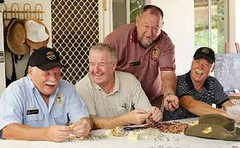 The humble penny may have been usurped by the one-cent piece when Australia adopted decimal currency on February 14, 1966 but the copper coin has proved a boon for a group of Sunshine Coast ex-servicemen.
The humble penny may have been usurped by the one-cent piece when Australia adopted decimal currency on February 14, 1966 but the copper coin has proved a boon for a group of Sunshine Coast ex-servicemen.
"Without wanting to be too dramatic, many Vietnam vets have been through some rough times," Barry confided.
"But the penny has brought about 50 of us on the Coast together, working for a common good. And the camaraderie born from this project is just wonderful."
Operating under the company name Digger Hat Jewellery, the Vietnam vets produce key rings, lapel badges, earrings and pendants in the shape of the iconic slouch hat. They also produce the iconic items of jewellery from halfpennies and sixpences – other pre-decimal currency coins.
Barry, a musician and career soldier, has no idea how many slouch hats have been fashioned by the group since they took over production five years ago but he suspects it is near 120,000.
But he does know that just on $200,000 raised from the sale of the slouch hats has been distributed to needy ex-servicemen or their dependants.
"In the early days I think this was viewed more as an activity than a business, but when we see the good it is doing for our mates, the tedium of the work is worth all the effort," he said. "It has helped me with some issues I had and I'm sure others feel the same way."
When Barry uses the word tedious, he is not kidding.
Getting a penny to the slouch hat key ring stage involves a minimum of 10 production points and that does not include accessing the pennies which are sourced from coin dealers.
Three groups of veterans – Monday Marvels, Caloundra Push and Breakfast Club – meet at Barry's Buderim home one day each month, kicking off the production line by drafting pennies into their respective year of production. The various steps that follow include cleaning and polishing the coin and pressing the crown and turning up the slouch. Most is done manually.
An estimated 700 slouch hats are produced in each three-hour session by the mostly conscripted veterans who range in rank from private to squadron leader.
To read the complete article, see:
Pennies from heaven boost Diggers
(www.sunshinecoastdaily.com.au/story/2009/11/21
/pennies-from-heaven-big-boost-for-diggers/)
1911 GOLD TIFFANY LIFE SAVING MEDAL OFFERED
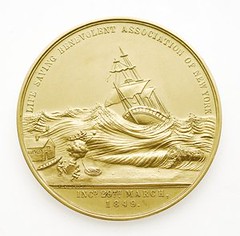 A 20ct gold Life Saving Medal designed by CH Lovett for Tiffany & Co, awarded to Alfred N Bevan in 1911 is going under the hammer on 30 November at Birmingham based auctioneers Fellows & Sons.
A 20ct gold Life Saving Medal designed by CH Lovett for Tiffany & Co, awarded to Alfred N Bevan in 1911 is going under the hammer on 30 November at Birmingham based auctioneers Fellows & Sons.
The medal was presented to Alfred N Beavan, captain of the steamship ‘Brika' for the rescue of three seamen from their sinking ship ‘Theresa' by the Life Saving Benevolent Association of New York (LSBA). The ship had been found in heavy sea 120 miles off St Michael's in the Azores.
The medal had been spotted in a consignment of gold which was due to be scrapped by Liverpool jewellers, W J Edwards.
Margot Walker and Peter Edwards, Partners of W J Edwards said: "This medal simply stood out as it was in impeccable condition when we found it. We realised that it must have been something special when we read the inscription on the back of the medal and simply had to find out more about it."
Stephen Whittaker, Managing Partner, Fellows & Sons said: "This Life Saving Medal is unique and carries an interesting history. Currently there is a tendency for jewellers to scrap gold but I am delighted that W J Edwards spotted the potential interest of this medal for collectors both here in the UK and the United States"
The medal has an estimate of £2,000 - £3,000 and will be sold with copies of the account from the New York Times in the Silver, Plated Ware, Coins & Medals auction on Monday 30 November.
To read the complete article, see: RARE MEDAL DISCOVERED BY LOCAL JEWELLERS (www.responsesource.com/releases/rel_display.php?relid=51883)
VICTORIA CROSS SELLS FOR RECORD 1.5 MILLION GBP
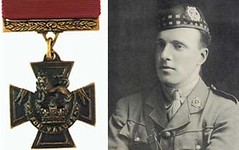 The "ultimate" gallantry medal – the only double Victoria Cross from the Great War – has been bought by Tory peer Lord Ashcroft for a world record price of nearly £1.5 million.
The "ultimate" gallantry medal – the only double Victoria Cross from the Great War – has been bought by Tory peer Lord Ashcroft for a world record price of nearly £1.5 million.
The story behind the gallantry medals of Captain Noel Chavasse is deeply moving: he was awarded the second of his VCs after dying from battlefield injuries in 1917. Since then at least 12 memorials have been erected worldwide in his honour – more than for any other recipient of the Commonwealth's most prestigious bravery award.
Captain Chavasse's service and gallantry medals were left by his family decades ago to St Peter's College, Oxford. The college has now sold the medals to Lord Ashcroft, the billionaire Tory peer. According to college sources, the price was "close to £1.5 million", easily topping the previous world record for a medal, rumoured to be a private sale worth £1 million.
The Chavasse medals are now guaranteed place of honour in the new Lord Ashcroft Gallery, which will open at the Imperial War Museum next year and which is being built with a £5 million donation from the Tory peer.
The gallery will house Lord Ashcroft's collection of VCs, which he started to build up in 1986. It is now the largest collection of VCs in the world and is estimated to be worth at least £30 million. VCs and George Crosses already owned by the museum will also go on display in the gallery.
To read the complete article, see:
Lord Ashcroft pays record price for 'ultimate' Victoria Cross
(www.telegraph.co.uk/news/uknews/6624138/
Lord-Ashcroft-pays-record-price-for-ultimate-Victoria-Cross.html)
WALL STREET JOURNAL ON RISING NUMISMATIC PRICES
Loren Gatch forwarded this article about the surge in prices for rare coins. Mentioned are the "million dollar cent" (and Warhol's "200 One Dollar Bills") that we discussed earlier. He writes:
Here's a Wall Street Journal article on the possible 'bubble' in numismatic prices. If the Feds already rescued AIG and General Motors, would a future bailout of Heritage Auctions really be so inconceivable?
 When is a penny worth a million dollars?
When is a penny worth a million dollars?
When it's a 1795 reeded-edge U.S. penny, one of only seven known to exist. It recently sold for nearly $1.3 million at auction—the first time a one-cent coin has cracked the million-dollar price barrier.
Today's coin market is largely defined by high-end investors grabbing the rarest of coins that infrequently come up for sale; gold bugs snapping up gold coins; and speculators bidding up prices for coins whose grades they suspect are too low, in the hopes of securing a higher grade and selling them for more money. Yet ordinary collectible coins—the nickels, dimes and quarters that are nice but not great—have fallen in value by as much as 30% over the past year, say coin dealers and auction-house executives.
"It's easier to sell a $100,000 coin today than a $1,000 coin," says John Albanese, founder of Certified Acceptance Corp., based in Bedminster, N.J., which verifies graded coins.
That mirrors the trend in other collectible markets, such as those for fine art, wine and jewelry. The high end of these markets is garnering big interest as investors increasingly worry about the weakening dollar and the potential for future inflation. Yet lower-end collectibles are struggling in the aftermath of the financial crisis.
Andy Warhol's 1962 silkscreen painting "200 One Dollar Bills" sold for $43.7 million to an anonymous buyer at a Sotheby's auction in New York—more than three times its high estimate of $12 million. Auctions this fall have established new price records for a host of fine-art photographers. And blue-chip wines such as Bordeaux from Chateau Lafitte, Petrus, Le Pin and Ausone "are on fire," says Charles Curtis, head of Christie's North American wine sales.
Sales of gold coins are up as much as 75% at Dallas-based online auction house Heritage Auctions Inc. "because there is just so much demand," says Jim Halperin, the auction house's co-chairman. "Even Warren Buffett is talking about inflation these days, and people I talk to who are buying coins are worried about a massive onslaught. They're buying coins because they want to hold something tangible that will do well."
To read the complete article, see: The Million-Dollar Penny (online.wsj.com/article/SB10001424052748703811604574533732182243424.html)
NEW YORK TIMES ON THE ADVANCE OF ELECTRONIC CASH
For almost as long as Americans have been hearing about jetpacks and picturephones, they have been hearing that money — bills, coins and plastic cards — might cease to exist, or at least become a novelty.
Instead of leather wallets, consumers could, sooner than they think, carry virtual wallets, with their credit card and bank information stored on remote computers that are accessible everywhere and anytime. They could use them whenever they want to buy something, whether on the Web, on cellphones or at cash registers.
With a new cellphone application called ShopSavvy, for instance, a shopper can use the phone's camera to scan an item's bar code in a store to see if it is available for less online. If so, the shopper can buy it with one click if they have already entered their credit card and shipping information on PayPal's Web site.
"What we're trying to do and what we think is very important is to displace the use of cash or checks," said Scott Thompson, president of PayPal, which is a leader in digitizing money. "We'll just have one wallet, and it lives in the cloud."
PayPal says its service makes the checkout process more convenient and secure for both shoppers and merchants.
The way consumers pay for things has transformed only a few times. Coins replaced bartering, paper bills mostly replaced coins, and bank drafts and checks developed as an alternative to cash.
In the 1950s, the credit card was introduced, and today, Americans pay for more on plastic than they do in cash. Some airlines and restaurants, for instance, no longer accept cash. The coming evolution to digital money that is handled over the Web is under way, led by companies like PayPal, MasterCard and Visa, as well as start-up companies and retailers. Some methods involve using a cellphone instead of a credit card, while others call for using a single password or code to tap into their credit cards.
"It just keeps getting more and more convenient to get access to your money and to transfer it to someone else," said Lawrence H. White, a professor of economics at George Mason University who specializes in the history of money. "When everyone has a cellphone, why reach into your wallet?"
To read the complete article, see:
At Checkout, More Ways to Avoid Cash or Plastic
(www.nytimes.com/2009/11/16/technology/start-ups/16wallet.html?
scp=1&sq=at%20checkout%20more%20ways%20to%20avoid%20cash%20or%20plastic)
GOT CASH? YOU'RE A CRIMINAL SUSPECT
Cash (at least larger sums of it) is being forced out of use by other means, writes Loren Gatch:In a world where financial transactions are increasingly electronic, using cash is not only old fashioned, but is increasingly considered prima facie evidence of criminal activity. This recent item from the New York Times illustrates the legal trend
Steve Bierfeldt, carrying some $4700 in cash as proceeds from the sale of "T shirts and bumper stickers" for the Ron Paul campaign, was detained by TSA screeners at the St. Louis airport, who questioned why Bierfeldt had the money. When he refused to explain, he was detained for questioning, and threatened with prosecution for possessing the money.
Unbeknownst to the federal officers, Bierfeldt taped their threats, and the case was quickly settled in Bierfeldt's favor through the intervention of the ACLU, which pointed out that the minimum amount of cash requiring reporting was $10,000, and that the TSA, which is only responsible for air travel security, overstepped its authority in any case.
This incident reminded me of a case from ten years ago--United States v. Bajakajian 524 U.S. 321 (1998). In that case, Hosep Bajakajian sought to take $357,144 in cash aboard an airplane without reporting the currency on the required customs form. As part of its prosecution of Bajakajian for failure to file the report, the government sought forfeiture of the entire amount. This penalty was struck down by the U.S. Supreme Court as a violation of Bajakajian's rights under the Eight Amendment against "excessive fines".
Fearful of the encouragement this case might give to money laundering, Congress later added to the 9/11-inspired USA PATRIOT Act language that defined the attempt to transport undeclared cash above the $10,000 threshold to be itself a "corpus delicti". This reversed the Court's findings in the Bajakajian case. Now, the crime isn't the mere failure to report having the currency, but the possession of currency itself—quite apart from whether that currency was obtained through legal or illegal operations.
In this subtle but real way, the possession and use of cash is becoming less legally legitimate.
To read the complete article, see: A Constitutional Case in a Box of Cash (www.nytimes.com/2009/11/17/business/17road.html?_r=1&hpw)
THE BOOK BAZARRE
M.V. LAKSHMINARAYANA'S NUMISMATIC MUSEUM
In this new era of e-mail, ipods, DVDs and other electronic gadgets of entertainment, the hobby of collecting stamps and currency is still alive in late M.V. Lakshminarayana's residence ‘Aparoopa' at Agrahara in city.
Lakshminarayana, an employee of State Bank of Mysore (SBM) in city, was in the habit of collecting postage stamps, greeting cards, ancient coins, currency notes, war medals, antique pieces, first day covers and comme-moration stamps, photography.
Over a period of 40 years, he has collected more than 15,000 stamps, coins and currency notes of about 150 countries and more than 350 war medals.
"My husband first began his collection in 1954. Initially it was only stamps, but later in 1963, when he got a job in the Bank, he took to collecting currency notes and with the help of his pen-friends in different countries, he started collecting currency notes of all countries," says Shantha.
"During the course of his job, when he had an opportunity to work at the Foreign Exchange Department, he befriended foreigners who visited the Bank to encash their Traveller's Cheques into Indian currency. He bought currencies of their countries by paying them their equivalent in Indian rupees. In this way, he collected both currency notes and coins of nearly 150 countries."
"Lakshminarayana also started collecting rare Indian currency notes bearing unusual serial numbers. At first he started collecting currency notes of denominations of Re.1, Rs.2, Rs.5 and Rs.10, bearing serial numbers 111111 to 999999. He used to wait for fresh currency notes that were being regularly sent to his Bank by the RBI from its Press (Cash Remittance). Whenever currencies with unique features were received, he immediately exchanged them with ordinary currency. It took nearly 10 years for him to collect notes bearing serial numbers in the above denominations and only nine such notes can be collected from 1,000,000 pieces of the same series," says Shantha.
"Then his hunt began for notes bearing serial numbers 123456 and 654321 (ascending and descending order). Since our currency notes start with the serial number 0000001 and end with 1,000,000, notes with the above numbers appear only once in a bundle of 1,000,000 pieces.
Among the ancient coins were forceps-shaped silver coin (Larin) minted in 1077 by Ali Adil Shah II of Bijapur and gold coins of Kanishka period. A coin released by the Ontario Government to commemorate the role of mining in the development of Canada issued in 1967 is an alloy of gold, nickel, zinc, platinum, silver, copper and iron.
Others in the collection include silver coins of East India Company minted in 1768 AD at Murshidabad, West Bengal, coins of Arcot Nawabs with Walajah as their capital minted perhaps in Tiruchi and gold and silver coins of Tipu Sultan. Silver pagodas of Madras Coinage minted in 1870-1808 had the figure of Lord Venkateshwara on one side with value in Tamil and Telugu and on the obverse a Gopuram with value written in English and Persian characters.
To read the complete article, see: Aparoopa: A unique museum to keep alive a unique hobby (www.starofmysore.com/searchinfo.asp?search1=4313&search2=specialnewsnew)
CHINESE ARTIST DUPLICATES BANKNOTE WITH EGG-SHAPED ROCKS
In the years between the end of World War II and Mao's declaration of the People's Republic of China in 1949, it is said that China's money was so worthless a single egg cost ¥10,000.
Perhaps one artist in Guangzhou, southern China, had that fact in mind when this sculpture was conceived. Except they got it backwards – it's a case of a thousand eggs being needed for a single banknote.
The work was based on the 50 yuan note designed in 1980.
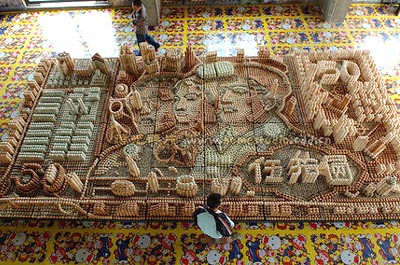

To read the complete article, see: Chinese Money Worth Weight in Eggs (www.weirdasianews.com/2009/11/20/chinese-money-worth-weight-eggs/)
SRI LANKA ISSUES BANKNOTE TO MARK END OF TAMIL WAR
Sri Lanka on Tuesday released a banknote to mark the end of the country's 37-year separatist war, following the crushing of Tamil Tiger rebels in May, the central bank said.
The first commemorative banknote in the 1,000-rupee (nine dollars) denomination was given to President Mahinda Rajapakse on Tuesday, the bank said in a statement.
"The valiant contribution made by the nation's victorious sons and daughters, of the security forces and the police, is the theme on the reverse of the note," the bank said in a statement.
"The design at the centre depicts the hoisting of the national flag by members of the security forces."
To read the complete article, see: Sri Lanka issues banknote to mark end of war (www.google.com/hostednews/afp/article/ALeqM5gSyqb-7OITAcscn_B_7h1NX5TEXQ)
Kavan also forwarded a link to another article which had this picture of the new note. -Editor
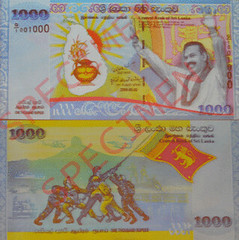
Kavan wrote up a detailed article and critique of the note. He submitted it to the Sunday Times, but they declined to publish it. It's posted on his web site. Here are some excerpts.
The front of the new currency note has a Black&White picture of the victorious president, His excellency Mahinda Rajapaksa with both his hands raised. It is the first time since 1954, that an image of a living person has been used on Lankan currency notes. Previously only portraits of British King George VI (1941-1951) and Queen Elizabeth II (1952-1954). Late Prime Minister S. W. R. D. Bandaranaike appeared on some currency issues from 1961 to 1975. The new currency note resembles the 1970 issue in which a portrait of the Late S. W. R. D. Bandaranaike with his hand raised was issued. That issue was withdrawn from circulation when it was deemed inappropriate by authorities to have a symbol "the hand" of the ruling SLFP political party prominently on currency issue.

The center piece is an image of five soldiers raising the national flag. The pose has clearly been plagiarized from the iconic World War II picture of American Marines raising the flag on Iwo Jima in 1945. The faces have slant eyes and the helmets, dress and boots unlike those currently used by SLA. I was unable to trace this photograph, in online image archives. It will be interesting to identify image if it is not just a drawing. The CBSL Press release nor the folder stated the name of the designer, as is customary.
To read Kavan's complete article, see: 2009 - Sri Lanka - 1000 Rupee note The Ushering of Peace and Prosperity (coins.lakdiva.org/commemorative/2009_mahinda_1000r_note.html )
KENYA MAY BAN PORTRAITS ON ITS BANKNOTES
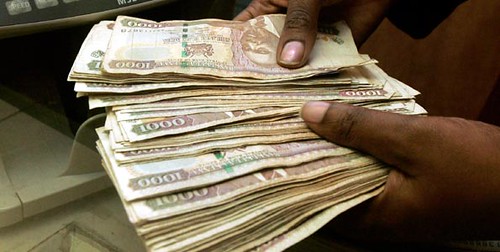
Kenya's coins and notes will not bear the portrait of any individual if the proposals in the new harmonised draft Constitution of Kenya are adopted.
The Committee of Experts, in a draft Constitution released on Tuesday, propose, "Notes and coins issued by the Central Bank of Kenya may bear images that depict or symbolise Kenya or an aspect of Kenya but may not bear the portrait of any individual."
This means that former presidents Jomo Kenyatta and Daniel Moi will be the only last personalities to have had portraits on the Kenyan currency.
Kenyans have a month to make their contributions on what they think of the proposals before changes are made to the draft constitution.
A referendum is scheduled for early march next year.
The history of Kenyan currency dates back to 1966, when the Central Bank of Kenya issued notes in denominations of Sh5, Sh10, Sh20, Sh50 and Sh100.
Kenya's first President Jomo Kenyatta appeared on the banknotes issued until 1978, with President Daniel Moi's portrait replacing him in 1980.
To read the complete article, see: Draft constitution: Kenya currency to exclude portraits (www.nation.co.ke/business/news/-/1006/687788/-/item/0/-/a2j0ph/-/index.html)
BANKNOTE 2009 CONFERENCE IN WASHINGTON DECEMBER 6-9

MPC GRAM editor Fred Schwan wrote:
Think how interesting it would be to be able to attend the annual banknote conference and meet with banknote designers and printers from all over the world. Imagine being able to have input into a new design, a new security feature and printing methods. For those of us who have designed MFC and other commemorative notes it would be like getting to the major leagues.
To be able to understand and learn how security problems are addressed and what is involved in producing banknotes for worldwide use. How much more goes into this process than scanning a picture into a computer and adding some wording and serial numbers. How the original engraving makes it to a finished note. All would be fascinating.
From the conference web site:
As the seventh in a series of regular conferences targeting organizations—from both government and industry—with an interest in the use of banknotes in the coming decades, Banknote 2009 will continue its balance of topical, relevant material with the opportunity for delegates to connect with other industry members.
The goal of Banknote 2009 is to bring together both the government and private industry sectors to focus on leading technologies and emerging trends in the banknote industry. The highly respected group of international speakers from manufacturers, suppliers, governments and law enforcement agencies will review and discuss various aspects of banknote design, production, issuance and usage.
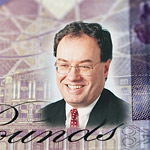 The Keynote speaker is
Andrew Bailey, chief cashier of the Bank of England. Speaker topics include:
The Keynote speaker is
Andrew Bailey, chief cashier of the Bank of England. Speaker topics include:
- Mapping technology for creation of innovative intaglio origination
- New soiling test method: anti-dirty fingers
- Digital Intaglio Plates & High-End 3D Quality Control
- How to Release the Artistic Design Talents of a Central Banker
- The magic in banknote substrates
- Digital Counterfeit Classification—The Need for a New Approach
- ColoUr blindness test for banknotes
- New Developments in Banknote Paper
- Latest Developments at the BEP
- Safety elements on new Danish Banknote Series
- Development of Security Features for the Next Generation of U.S. Currency
For more information, see: Banknote 2009 (www.banknoteconference.com)
SOMALI PIRATES CHECK RANSOM CASH FOR COUNTERFEITS
With thanks to the Pirate Speak Translator at www.talklikeapirateday.com/translate/, here's a story about Somali pirates and counterfeit money. Don't even THINK about thieving a thief! -Editor
From parachuted bundles of dollar bills to suitcases of cash transiting through east African capitals, there are many ways to deliver ransoms to Somalia's modern-day buccaneers.
The ransom handover is the most critical time in the hijacking of a ship; the single moment when the pirates, but also the crew, are at their most vulnerable.
On Tuesday, pirates who had been holding the Spanish tuna trawler Alakrana said they were about to release it after receiving four million dollars and its crew of 36 but were in the process of "checking the money".
When the luxury French yacht Le Ponant was hijacked by pirates last year, an estimated 1,2 million dollars were delivered to secure the ship's release, according to sources close to the pirates.
According to several businessmen in northern Somalia who refused to be named, part of the cash the French paid was counterfeit and virtually impossible to use.
Since that incident, which took place in April 2008, the pirates started taking more precautions and bringing counting machines and counterfeit money detectors on board.
Some pirates were already very specific on the notes that should be used for the ransom, demanding only 100 and 50 dollar bills and refusing certain years of issue.
"They won't take any $100 bills from 1996 and they also try to avoid the very recent bills, out of fear they can be traced more easily," said one Somali source who was involved in several negotiations.
To read the complete article, see:
Ransom - the hole in Somali pirates' net
(www.iol.co.za/index.php?set_id=1&click_id=87&
art_id=nw20091117153122306C465771)
SPANISH SCIENTISTS TRAIN MOUSE TO DETECT COUNTERFEIT COINS
Counterfeiting is as old as money itself, with the history of currency including a millennia-long arms race between mints and the forgers that copy them. While governments have finally crafted paper money so intricate that counterfeiting isn't a major problem, detecting counterfeit coins remains a challenge. Now, Spanish scientists have modified a regular optical computer mouse to create a cheap and easy device for sniffing out phony Euro coins.
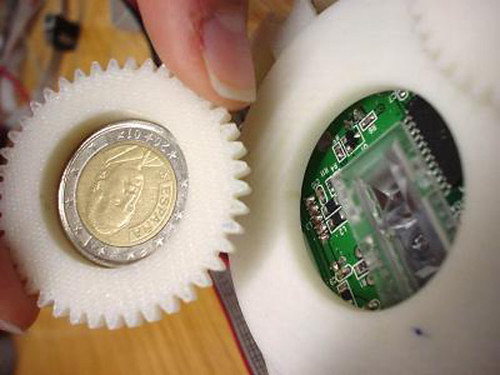
The device utilizes the sensor on the mouse to detect the minute details etched into the surface of the coin. The user loads a coin into the detector, which then references the coin against a database of legit currency. The sensor can detect even the slightest mistakes on the engraved map of Europe on the back of every Euro coin, making it easy to detect all but the most perfect facsimiles.
The mouse modification is cheap and easy, and the researchers who invented it say the same technique can be applied to webcams, too. So far, the device is only designed to analyze 2-Euro coins, the currency that makes up 79 percent of all counterfeit coins in Europe, but expanding the range would only require updating the database, and making a different sized coin holder.
To read the complete article, see:
Spanish Scientists Mod Optical Mouse Into Counterfeit Coin Detector
(www.popsci.com/technology/article/2009-11/
spanish-scientists-mod-optical-mouse-counterfeit-coin-detector)
WOMAN LEAVES $40,000 AT SHRINE FOR SAFEKEEPING
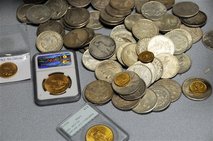 A woman quietly left $40,000 worth of rare U.S. coins near a Catholic shrine for safekeeping so the Virgin Mary could watch over her life savings while she was out of town, and apparently it worked: The money was returned to her when she got back a week later.
A woman quietly left $40,000 worth of rare U.S. coins near a Catholic shrine for safekeeping so the Virgin Mary could watch over her life savings while she was out of town, and apparently it worked: The money was returned to her when she got back a week later.
Operators of the National Shrine Grotto of Our Lady of Lourdes near Emmitsburg thought they had been blessed with a big donation when a groundskeeper found the two plastic freezer bags filled with gold and silver while raking leaves.
But Shrine Director William Tronolone said the woman approached him after a noon Mass Sunday, six days after the discovery, to ask whether anyone had found some coins she had hidden beneath fallen leaves at the site on the campus of Mount St. Mary's University.
"I said, 'Why did you leave it there?' And she said, 'Well, I had to go away and I was afraid to leave it and I wanted the Blessed Mother to watch over it for me — and evidently she did because you found it,'" Tronolone said.
By then, university officials had had the coins appraised, notified police and placed the money in a safe while awaiting word from investigators.
To read the complete article, see: Woman leaves $40,000 at Md. shrine for safekeeping (news.yahoo.com/s/ap/20091118/ap_on_fe_st/us_odd_grotto_hidden_coins)
FEATURED WEB PAGE: MONEY HATS
This week's Featured Web page has images of Origami hats made for the portraits on world banknotes. Very clever!
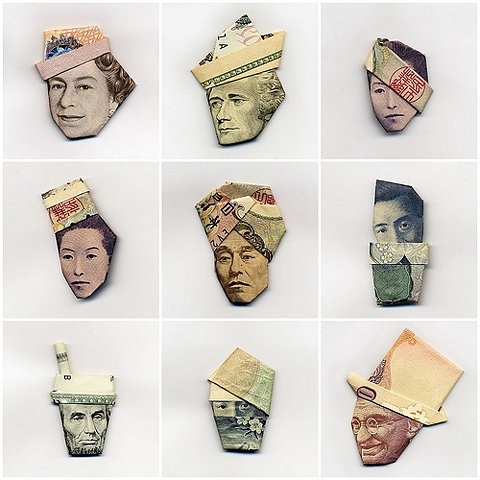
blog.makezine.com/archive/2009/11/money_hats.html
